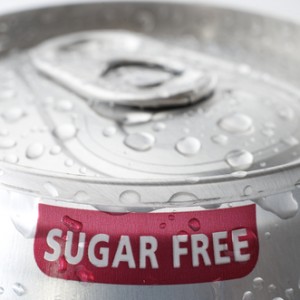 A new study by researchers at the University of Texas Health Science Center (UTHSC) at San Antonio published this week in the Journal of the American Geriatrics Society has found higher diet soda intake to be directly linked to higher incidence of abdominal obesity in adults 65 years of age and older. These findings elevate concern regarding safety of chronic diet soda consumption, since increased belly fat can contribute to greater risk of metabolic syndrome and cardiovascular disease. According to the NIH, in persons with a large waistline, AKA abdominal obesity or “having an apple shape,” excess fat in the stomach area is a greater risk factor for heart disease than excess fat in other parts of the body, such as on the hips.
A new study by researchers at the University of Texas Health Science Center (UTHSC) at San Antonio published this week in the Journal of the American Geriatrics Society has found higher diet soda intake to be directly linked to higher incidence of abdominal obesity in adults 65 years of age and older. These findings elevate concern regarding safety of chronic diet soda consumption, since increased belly fat can contribute to greater risk of metabolic syndrome and cardiovascular disease. According to the NIH, in persons with a large waistline, AKA abdominal obesity or “having an apple shape,” excess fat in the stomach area is a greater risk factor for heart disease than excess fat in other parts of the body, such as on the hips.
Metabolic syndrome — one of several public health consequences associated with America’s obesity epidemic — refers to a constellation of factors causing increased risk high blood pressure, heart disease, diabetes, and stroke. Risk increases with the number of metabolic risk factors you have. In general, a person with metabolic syndrome is twice as likely to develop heart disease and five times as likely to develop diabetes as someone who doesn’t have metabolic syndrome. According to the World Health Organization (WHO), an estimated 1.9 billion adults worldwide were overweight (body mass index [BMI] of 25 or more) in 2014. Of that cohort, 600 million individuals fell into the obese range (BMI of 30 or more) — a metric that has alarmingly more than doubled since 1980.
A UTHSC release notes that in attempting to combat obesity, many people endeavor to reduce their sugar intake by substituting nonnutritive or artificial sweeteners, such as aspartame, saccharin, or sucralose. However, previous research is cited showing that over the past three decades, as intake of artificial sweeteners and diet soda have increased substantially, that has been accompanied by a dramatic increase in the prevalence of obesity during that same time interval. However, the preponderance of research investigating diet soda consumption and cardiometabolic diseases have studied its effect on middle-aged and younger adults.
The American Geriatrics Society journal paper, entitled “Diet Soda Intake Is Associated with Long-Term Increases in Waist Circumference in a Biethnic Cohort of Older Adults: The San Antonio Longitudinal Study of Aging,” (Journal of the American Geriatrics Society, March 17, 2015 DOI: 10.1111/jgs.13376), coauthored by Sharon P.G. Fowler, Ken Williams, and Helen P. Hazuda of the University of Texas Health Science Center at San Antonio Department of Medicine, at San Antonio, Texas. Mr. Williams is also associated with KenAnCo Biostatistics of San Antonio. This Prospective cohort study shifts the demographic focus of research to diet soda consumption’s effects on adults over the age of 65, with its objective to examine the relationship between diet soda (DS) intake (DSI) and long-term waist circumference (WC) change (WC) in the biethnic The San Antonio Longitudinal Study of Aging (SALSA).
 “Our study seeks to fill the age gap by exploring the adverse health effects of diet soda intake in individuals 65 years of age and older,” explains the study’s lead author — UTHSC’s Sharon Fowler, MPH, a faculty associate in the division of clinical epidemiology in the Health Science Center’s department of medicine. “The burden of metabolic syndrome and cardiovascular disease, along with healthcare costs, is great in the ever-increasing senior population.”
“Our study seeks to fill the age gap by exploring the adverse health effects of diet soda intake in individuals 65 years of age and older,” explains the study’s lead author — UTHSC’s Sharon Fowler, MPH, a faculty associate in the division of clinical epidemiology in the Health Science Center’s department of medicine. “The burden of metabolic syndrome and cardiovascular disease, along with healthcare costs, is great in the ever-increasing senior population.”
SALSA examined 749 Mexican-American and European-American individuals aged 65 and older, and 474 (79.1%) of survivors completed follow-up 1; 413 (73.4%) completed follow-up 2 , and 375 (71.0%) completed follow-up 3. Participants completed a mean of 2.64 follow-up intervals, for 9.4 total follow-up years. DSI, WC, height, and weight were measured at outset and at the conclusion of each interval.
The researchers report that adjusted for initial WC, demographic characteristics, physical activity, diabetes mellitus, and smoking, mean interval WC of DS users was almost triple that of non-users, and that in waist circumference increase among diet soda drinkers, per follow-up interval, was almost triple that among non-users: 2.11 cm versus 0.77 cm, respectively. After adjustment for multiple potential confounders, this translates to interval waist circumference increases of 0.77 cm /0.80 inches for non-users, 1.76 cm / 1.83 inches for occasional users, and 3.04 cm / 3.16 inches for daily users over the total 9.4-year SALSA follow-up period. Using ANCOVA repeated-measures, the researchers compared mean WC for DSD users vs. non-users in all follow-up periods, adjusted for sex; baseline WC, age, ethnicity, education, neighborhood, leisure physical activity, diabetes and smoking status; and length of follow-up. Overall, DSD users experienced 70 percent greater increases in WC compared with non-users.
A positive relationship emerged between DSD use and subsequent WC, with point estimates for WC 63% higher in daily DSD users than in non-users, but this difference was not significant. Among frequent users (>=2 DSDs/day), however, mean increases in WC were 5 times greater than those in non-users. The coauthors conclude that in a striking dose-response relationship, increased diet soda intake was associated with escalating abdominal obesity, a potential pathway for cardiometabolic risk in this aging population.
Because WC is widely used as a proxy indicator of visceral adiposity, which is a major risk factor for diabetes, cardiovascular disease, cancer, and other chronic conditions, these results suggest that a national drive to reduce sugar-sweetened drink consumption that promotes substitutionary consumption of DSDs, may ironically have the opposite unintended effect, and the researchers suggest that data from this and other prospective studies indicate that promotion of diet soda as a healthier alternative to sugar-sweetened soda or other sweetened beverages may be ill-advised — they may be free of calories, but not of negative consequences.
In a presentation based on earlier research she delivered at the American Diabetes Association’s 65th Annual Scientific Sessions at San Diego in 2005, Dr. Fowler noted that “On average, for each diet soft drink our participants drank per day, they were 65 percent more likely to become overweight during the next seven to eight years, and 41 percent more likely to become obese.”
“The SALSA study shows that increasing diet soda intake was associated with escalating abdominal obesity, which may increase cardiometabolic risk in older adults,” Dr. Fowler concludes. The study coauthors recommend that older individuals who drink diet soda daily, particularly individuals with high cardiometabolic risk factors in play, try to cut consumption of artificially sweetened beverages.
In her 2005 observations, Fowler pointed out that whenever someone is drinking a diet soda, he or she is drinking it to the exclusion of healthier alternatives such as milk, water, or juice. She suggested asking oneself: “Can you think of one good thing that comes from a diet soft drink can for your body?” noting that at best when drinking diet soda “You’re giving yourself the taste of nourishment without any at all, so it may be that you then seek it from other foods, such as high-calorie desserts. Even though you fool your tongue, you don’t fool your brain. It is not satisfied. I’ve seen people plunk down a doughnut and a diet soda on a convenience store counter. What our analyses indicate for sure is that drinking diet soft drinks will not protect a person from the health effects of the rest of his or her lifestyle.”
Sources:
Wiley
Journal of the American Geriatrics Society
The San Antonio Longitudinal Study of Aging (SALSA)
University of Texas Health Science Center (UTHSC) at San Antonio
Image Credit:
University of Texas Health Science Center (UTHSC) at San Antonio


